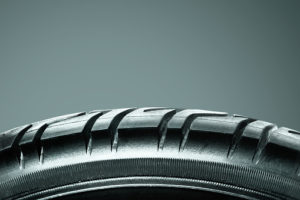
1. The Penny Test
There’s a very easy, inexpensive way to test your tire tread depth at home. Take a penny, and with Lincoln’s head upside down, put it between the tread of your tire. If you can’t see the top of Lincoln’s head, you still have more than 2/32 of an inch of tread remaining. If you are able to see the top of Lincoln’s head, there’s an unsafe amount of tread left and it’s time to get new tires.
2. Tire Wear Indicator Bar
Today’s tires have a wear indicator bar built in to warn you when they should be replaced. These bars are barely visible when the tires are new, and begin to become visible as the tread wears down. They look like flat rubber bars that run perpendicular to the direction of the tread. If one or more of these are visible on a tire, the tread is getting low.
3. Cracks on the Sidewall
Tire damage can appear on the sidewall. This will appear as distinct tracks or grooves that are visibly noticeable. Sidewall cracks can also be a sign that your tire is developing a leak.
4. Bulges or Blisters
As the outer surface of a tire begins to weaken, it can develop bulges or blisters on the surface. These are weak areas that can cause the tire to blow out unexpectedly.
5. Excessive Vibration
A certain level of vibration is to be expected while you’re driving, especially depending on road conditions. An out-of-balance wheel creates excessive vibration that will become progressively worse as you increase speed. The vibration will usually start at around 40 – 50 mph. There are several things that could cause this. Your tires could be misaligned or unbalanced, or your shock absorbers may need to be replaced. There could also be a problem inside the tire itself.
If you’ve noticed any of these signs, it’s time to schedule an appointment with Gurney’s! We have great deals for cars, trucks, and SUVs on top brands like Michelin, BFGoodrich, and Uniroyal. Give us a call or request an appointment online.


